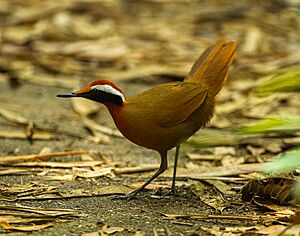Rail-babbler facts for kids
Quick facts for kids Rail-babbler |
|
|---|---|
 |
|
| Conservation status | |
| Scientific classification | |
| Genus: |
Eupetes
|
| Species: |
macrocerus
|
The rail-babbler or Malaysian rail-babbler (Eupetes macrocerus) is a unique bird. It looks a bit like a rail and lives on the ground. This bird is mostly brown with some black and white parts. It's the only species in its group, called Eupetes, and its own family, Eupetidae.
Rail-babblers live in the thick, old forests of the Malay Peninsula and Sumatra. They also live in Borneo. These birds are related to crow-like birds found in Africa. Sadly, their numbers have dropped a lot. This is because many of the old lowland forests where they live have been cut down. Forests that have grown back often don't have enough shade or are too dense for them.
However, you can still find them in some forests that have been logged. They also live on hillsides. So, they are probably not in immediate danger of extinction. These birds are quite shy and hard to spot. This means we don't know a lot about them.
Contents
What is a Rail-Babbler?
The rail-babbler is a medium-sized songbird. It is quite slender, measuring about 28 to 30 centimeters (11 to 12 inches) long. It weighs around 66 to 72 grams (2.3 to 2.5 ounces). This bird has a long, thin neck and a long, black bill. It also has long legs and a long tail.
Its feathers are mostly brown. The top of its head is a bit more reddish. Its chin and throat are a rich chestnut color. It has a long, black stripe that goes from its bill to the side of its neck. Above this stripe, there is a wide, white stripe.
Special Blue Skin
On the side of its neck, the rail-babbler has a patch of bare, blue skin. You can see this blue skin when the bird calls or shows off. Scientists think this blue patch helps the birds communicate with each other. This is especially useful in the dim light of the forest floor.
Both male and female rail-babblers look the same. Young birds look similar to adults but are duller in color. They have a whitish throat and a dark grey-brown belly.
Sounds and Calls
The rail-babbler makes a long, steady whistling sound. When it feels worried or upset, it makes a series of sounds that sound like a frog.
Where Rail-Babblers Live
You can find rail-babblers in the Malay Peninsula. This includes southern Thailand and Peninsular Malaysia. They also live on the big islands of Sumatra and Borneo. You can also find them on the Natuna Islands.
These birds mostly live in tall, lowland forests. They can also be found in swamps and a type of forest called heath forest. Sometimes, they live in lower mountain forests. In Peninsular Malaysia, they can be found up to about 1,060 meters (3,480 feet) high. In Sumatra and Borneo, they live up to about 900 meters (3,000 feet) high.
Why They Are Threatened
The number of rail-babblers is believed to be going down. This is because their forest homes are being lost or damaged. Because of this, they are listed as near threatened. This means they could become endangered if we don't protect their habitat.
How Rail-Babblers Live
The rail-babbler is a very shy and secret bird. It spends its life on the forest floor. It walks like a rail, bobbing its head like a chicken. When something disturbs it, it prefers to run away rather than fly.
What They Eat
Rail-babblers mainly eat insects. This includes cicadas and beetles. They also eat spiders and worms. When they are looking for food, they will quickly dash after their prey.
Life Cycle and Reproduction
We don't know much about how rail-babblers raise their young. Eggs are usually laid around January and February. Young birds that have just left the nest have been seen in June.
Their nest is often built close to the ground. It might be on a pile of dead leaves among plant stalks. The nest is usually about 30 centimeters (12 inches) off the ground. It is shaped like a cup and made from plant fibers. A female rail-babbler usually lays two plain white eggs. Beyond this, not much else is known about their breeding habits.


